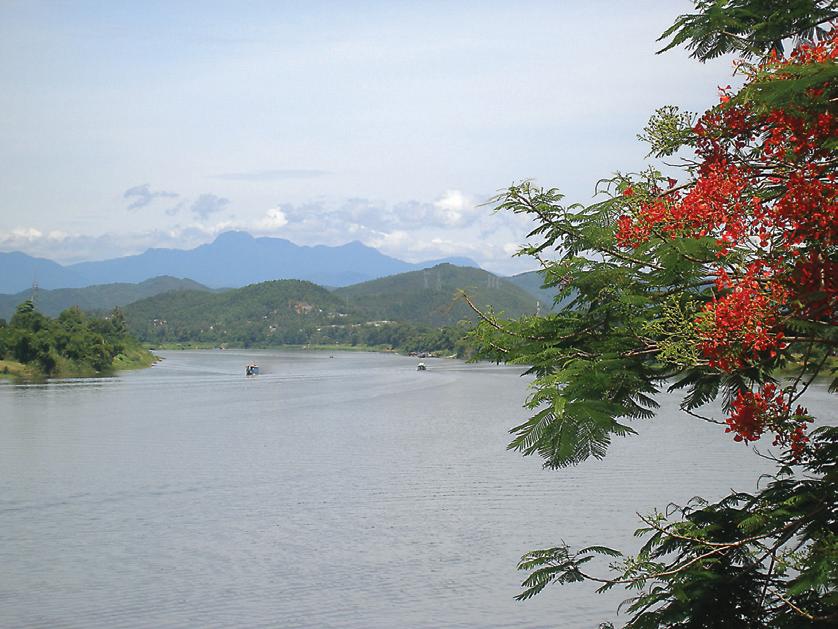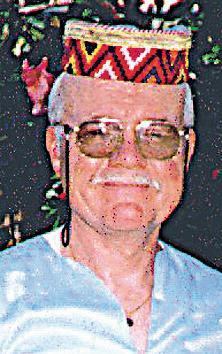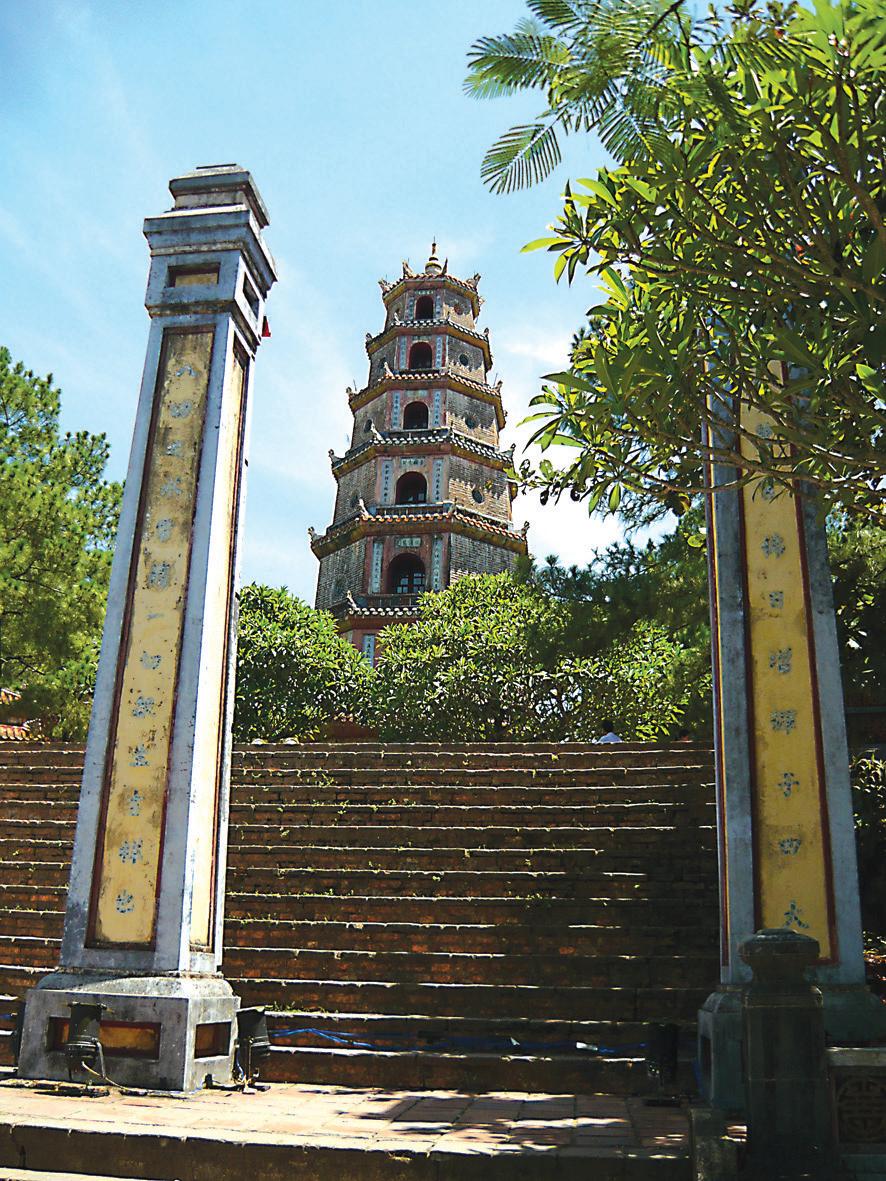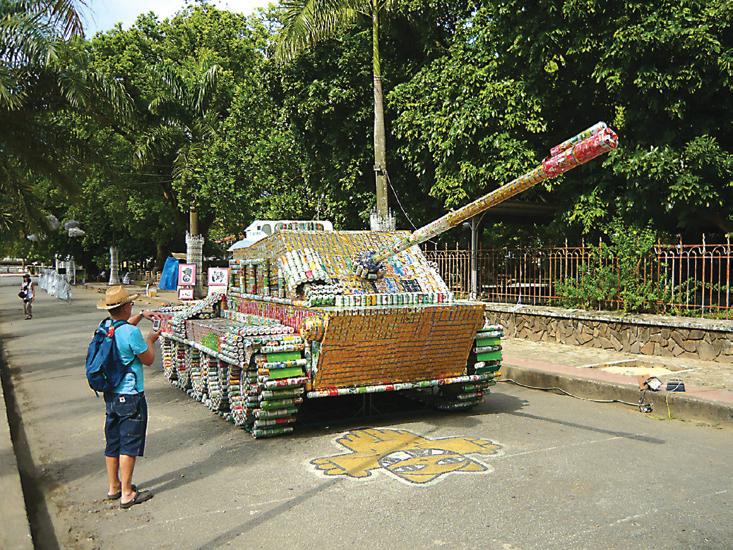
4 minute read
Huehurrywithout
from 2010-07 Melbourne
by Indian Link

A pleasant river cruise brings alive Vietnam’s religious and historical landmarks
BY THOMAS E KING
Serpentine waterways wing their way through many well known cities in Southeast Asia. The Chao Phraya, for instance, slices through Bangkok while the Klang bisects the Malaysian capital of Kuala Lumpur. The Huong River, on the other hand, isn’t a familiar haunt with many globetrotters so I felt fortunate to have had a leisurely encounter with the evocatively named Perfume River last month.
dragon boats were temporarily moored. Rising beyond several brilliant flame of the forest trees lining the river bank was an octagonal tower. Hue is a city of pagodas with more than 300 sacred Buddhist buildings gracing this city of 400,000 residents. Built in 1844, the seven tiered Thap Phuoc Duyen Tower was constructed on the grounds of the older Thien Mu (Heavenly Lady) Pagoda.
Hue is a city of pagodas with more than 300 sacred Buddhist buildings gracing this city of 400,000 residents
Stretching just 80 km - much of this journey is amid forests and fields of aromatic plants - the wide river cleaves the Vietnamese city of Hue into two divisions. Located roughly midway between the unbridled frenzy of Ho Chi Minh City - more commonly called Saigon - to the south and the more conservative Hanoi, the capital of the 86 million-strong Socialist Republic of Vietnam to the north, the provincial capital of Hue (pronounced Hway) has long been one of the nation’s main religious and educational centres. I gained a valuable introduction into its cultural attributes and saw a variety of its historical landmarks during a pleasant river excursion in a boat ‘guarded’ by twin dragons. “They symbolise double power,” said Ngoc, my genial and ever-smiling guide who not only provided detailed commentary on Hue but also acted as an interpreter when I tried to speak with older residents who weren’t conversant in English.
One of those was Mr Lu who piloted the dragon boat during the 5 km morning cruise. Previously employed as a fisherman, he said he now enjoyed showing his city to visitors from around the world. We chatted - courtesy of Ngoc’s fine translation skills - as the aluminium craft cut through the water and then coasted to a rustic riverbank jetty where scores of other
Buddhism came from India and then spread throughout Vietnam. Today 90 per cent of the population now profess the gentle faith. Several dozen adherents currently live at the monastery which is mercifully quiet once the tourist hordes leave. The sweeping scene of river boats and the purple hue of the Troung Son Mountain Range beyond was enticing but another major point of interest was only a few km upstream.
Also set above the Perfume River, the Tomb of Minh Mang is the most typical and best preserved of all the royal mausoleums in Hue. Said to be modelled after the Ming Tombs in Beijing, the 18 ha. complex is filled with statues, temples, terraces and stone bridges. In the middle of it all is a large hill of earth where the emperor rests shaded by pines. The exact location of the tomb is unknown because, Ngoc explained, much gold and silver was interred with the revered royal ruler.
Minh Mang who ruled from 1820 – 1840 was the second emperor in the Nguyen Dynasty, a line of hereditary rulers which lasted for 143 years. All 13 Nguyen emperors lived in a massive fortified expanse spread over the northern bank of the Perfume River. In 1802, after nearly 40 years of conflict, Vietnam was united for the first time by a Saigon lord, Nguyen Phuc Anh. He proclaimed himself Emperor Gia Long as the first Nguyen ruler and began rebuilding the Phu Xuan Citadel into an impregnable stronghold, the first fortified city in Asia modelled on European military design.
Fortified is the operative word because the 10 km in circumference Citadel has an 8 metre high, 21 metre thick outer wall. Inside this 520 ha stronghold where subjects lived, worked and tended fields was another moat-enclosed space, the Inner City or Dai Noi. Accessible through four entrances, access through the Ngo Mon Gate was once reserved solely for the emperor.
I walked unhindered through this passageway, across the stone Golden Water Bridge which spans a fish-filled lotus pond and into a still grand palace where emperors would confer with advisors, meet other nobles and issue royal decrees. The elevated red and gold
1. Central Vietnam’s river and mountain splendour unfolds only a few km beyond the busy urban centre
2. The Golden Water Bridge was once reserved for the exclusive use of Nguyen emperors
3. A couple celebrates their newly wed happiness before the moated entrance to the Citadel’s Inner City

4. The ornate octagonal Thap Phuoc Duyen Tower is regarded as the symbol of the cultured city

5. Hue remains a centre of the arts with displays showing works of cutting edge - or odd - design throne where this occurred takes centre stage in the Thai Hoa (Supreme Peace) Palace, a spacious hall with an ornate roof supported by 80 carved, gold inlaid and lacquered columns.

When the emperor tired of curtsies, courtesies and ceremonies he would retire to the third walled enclosure known as the Forbidden Purple City. This 10 ha. inner sanctum was designed for the exclusive use of the emperor, his family, numerous concubines and an entourage of eunuchs who not only acted as servants but often wielded much of the power behind the throne. Anyone else who breached the sanctity of the Forbidden City usually received a one way ticket to the next world!
The remaining architectural treasures of the Citadel - many of which were destroyed during the Vietnam War - and a substantial part of Hue are located on the north side of the Perfume River. The city’s southern sector also contains many residences and commercial outlets but for tourists this part of the city is the most user friendly because has the greatest selection of shops, restaurants and hotels.
Linking the two parts are several steel structures though one veteran stands out from the rest, the nearly 125 year old Truong Tien Bridge. It’s the longest legacy left by the French who played a significant role in Vietnam and left their mark in many cities.
I negotiated a fare and then entered a cyclo outside the Citadel for a cycle rickshaw ride across the bridge and along tree lined streets to my hotel. The night air was warm and humid and I had no reason to hurry back to dream about Hue. Nothing could have been better than what I had seen: the palaces, pavilions and pagodas as well as the peace that has come to this privileged city on the Perfume River.









